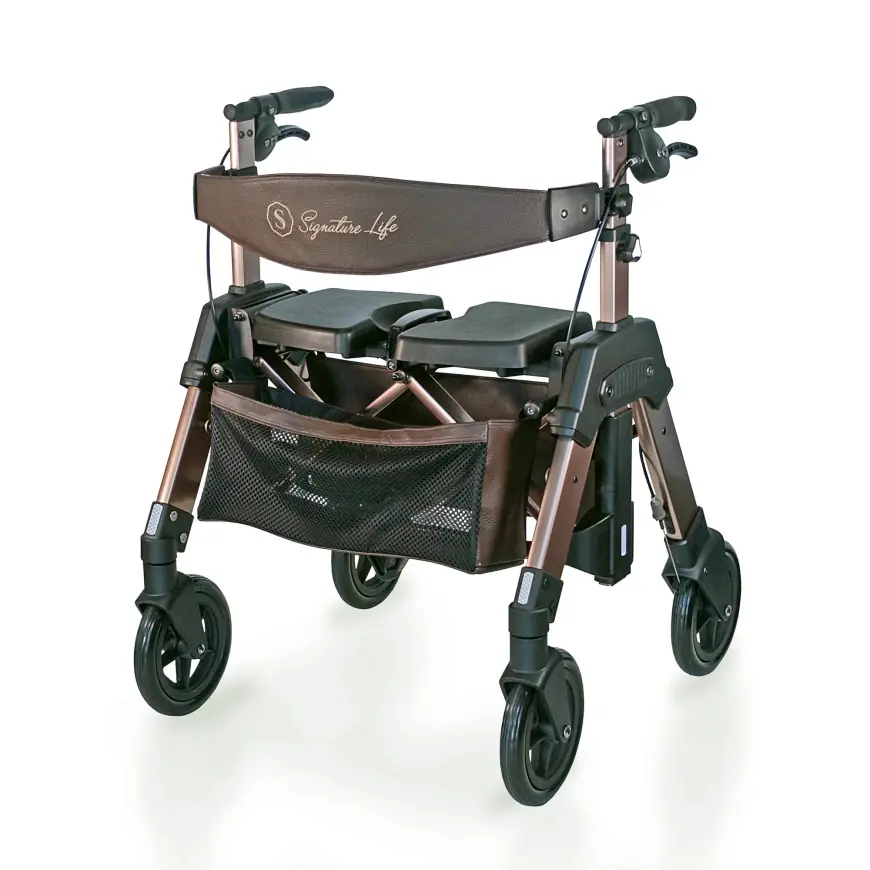Important Features to Look for When Buying a Walker with Chair
A rollator walker with seat, or a walker with incorporated chair, is a multi-functional mobility aid. It's an indispensable piece of equipment that incorporates support and comfort, allowing individuals—particularly elderly and post-surgery individuals—to rest and stay independent when necessary.

A rollator walker with seat, or a walker with incorporated chair, is a multi-functional mobility aid. It's an indispensable piece of equipment that incorporates support and comfort, allowing individuals—particularly elderly and post-surgery individuals—to rest and stay independent when necessary.
With numerous models to choose from, identifying which features to prioritize will guarantee you or your loved one the optimal selection for both mobility and lifestyle requirements. Regardless of whether you require a walker for indoors, outdoor activities, or both, below are the most significant features to look for when deciding on your purchase.
1. Seat Comfort and Size
One of the major reasons to opt for walkers with chairs is that you can rest and sit as required. That makes seat quality one of the most critical features.
-
Padded seats provide greater comfort with long-term use, particularly for people who suffer from joint or back problems.
-
Seat width and depth must fit the user's body size. Ensure it's broad enough to be comfortable but not overly wide to restrict movement.
-
Seat height is also crucial—it must enable the user to get on and off easily without putting stress on knees or hips.
-
Some walkers also feature backrests, which provide an additional level of support and more secure sitting
2. Weight Capacity and Endurance
Each walker comes with a maximum weight capacity, often between 250 and 400 lbs. Always verify this measure to guarantee the walker is strong enough for the user safely.
-
For heavier users, heavy-duty walkers (commonly referred to as bariatric walkers) are made with stronger frames and bigger seats.
-
Aluminum frames are also preferred for being light yet strong, perfect for daily use.
-
If the walker will be frequently utilized outdoors, look for rust-proof materials and a heavy-duty frame that can endure wear and tear.
3. Maneuverability and Wheel Size
The wheels of the walker will decide how smoothly it glides over various surfaces.
-
6-inch wheels will be adequate for even indoor surfaces.
-
8-inch or larger wheels provide better stability and ease of movement on uneven terrain like sidewalks, grass, or gravel.
-
Swivel front wheels offer better maneuverability, which is helpful in tight indoor spaces or crowded areas.
If you’ll be using the walker both indoors and outdoors, go for a model with larger wheels and better shock absorption.
4. Folding and Portability
Many people choose walkers with chairs because they’re portable and easy to transport.
-
A foldable frame simplifies storage in a car trunk or tiny closet.
-
Prefer lightweight walkers that are one-hand foldable or quick-release for ease of use.
-
Some models stand upright even when folded, a bonus for cramped areas.
Portability is particularly helpful if the walker will be used for travel, visits to the doctor, or errands.
5. Height Adjustability
The proper height is necessary for safe and ergonomic use. The handle height on the walker must enable the user to walk in a natural, erect posture.
-
Select a walker with adjustable handles, usually adjustable from 31 to 38 inches.
-
Correct height eliminates strain on shoulders, wrists, and back, avoiding long-term pain.
When testing height, the elbows of the user should be bent at a 15–20-degree angle when grasping the grips.
6. Brakes and Safety Features
-
A chair walker should be safe—not only when walking but particularly when sitting down.
-
Most walkers have hand brakes that can be squeezed to brake or locked on when seated.
-
Opt for loop-style brakes that are easy to grasp and use, even for people with arthritis.
-
Some have cane holders, reflectors, or safety straps to offer even more security and convenience.
Brakes are a must-have. Without a dependable brake, the user is in danger of slipping or tipping when trying to sit. Affinity Home Medical offers the best walkers with chair to make your life easy and comfortable.
7. Storage and Accessories
Chair walkers tend to also serve as an easy-to-move storage device.
-
Check for an integrated storage pouch or basket to hold personal items, groceries, or medical supplies.
-
Opt for accessories such as cup holders, trays, or oxygen tank holders based on individual requirements.
-
Removable or zippered storage is available on some high-end models that can be detached and taken in hand.
Having a secure area to place things makes the walker more useful and easier to use.
8. Price vs. Value
Although it is tempting to get the cheapest walker, don't sacrifice important features such as safety, comfort, and durability.
-
Part or all of the expense can be paid for by insurance or Medicare if the walker is medically required and prescribed by a physician.
-
Balance price with the essential features for your personal requirements.
-
A little extra investment usually leads to increased longevity and less repair.
Final Thoughts
Purchasing a walker with a seat is not merely about mobility—it's about freedom, comfort, and confidence in day-to-day living. By focusing on key features such as seat comfort, brake mechanisms, wheel diameter, and adjustability, you can select a walker that addresses both mobility and lifestyle requirements.
Take the time to evaluate the user's living situation on a daily basis, health at this time, and long-term requirements before making a model choice. And whenever possible, try out the walker in person to make sure it's just right. With the correct selection, a chair walker can be a life-enhancing device that facilitates independent, safe living.
What's Your Reaction?
 Like
0
Like
0
 Dislike
0
Dislike
0
 Love
0
Love
0
 Funny
0
Funny
0
 Angry
0
Angry
0
 Sad
0
Sad
0
 Wow
0
Wow
0


















































